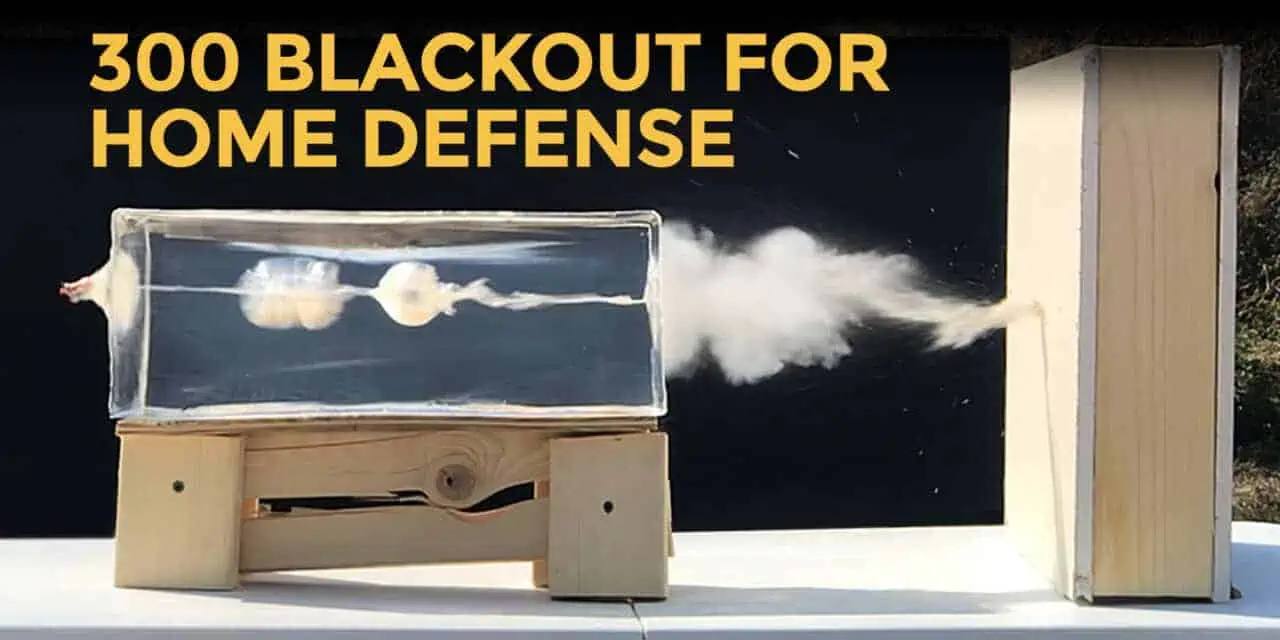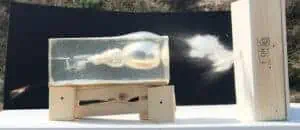300 Blackout first appeared on the scene in 2011 as a “do it all” cartridge for the AR platform. One of the great things about 300 Blackout is that it is available as both a supersonic round and a subsonic round. Supersonic 300 Blackout has bullet weights and velocities that are similar to 7.62x39mm ammunition. Subsonic 300 Blackout, on the other hand, has bullet weights around 200 grains and is quite similar to 45 ACP. Guns and ammo don’t exist in a vacuum, though, so today we’ll be looking at the idea of 300 Blackout for home defense.
There are a lot of advantages at first glance for using 300 Blackout for home defense. 300 Blackout was designed from the ground up to use a suppressor and subsonic ammunition. Guns are loud (really loud) and using a firearm without a suppressor indoors can cause permanent hearing damage to yourself and your loved ones.
Another advantage to using 300 Blackout for home defense is how it works with AR pattern guns. The AR-15 is one of the most-common rifles in America and is an excellent self-defense firearm. 300 Blackout uses the standard AR-15 magazine, as well as many receiver parts. This means that if you can just as easily shoot an AR-15 chambered in 300 Blackout as you can an AR-15 chambered in 5.56mm or .223 well.
Optimizing 300 Blackout for Home Defense
We know from previous testing that subsonic 300 Blackout ammunition is more than up to the task of stopping a threat to our lives. The question we’ll be answering today is, how effective is 300 Blackout for home defense? What happens if you miss the target, and your round goes sailing off through an interior wall? What effect might that have on an innocent person behind that wall? Preventing innocent people from being injured by guns is the reason why we have the four rules of gun safety. Our accuracy can degrade in a stressful situation when lives are on the line, and we can miss the target and hit something else. Therefore, a good home defense ammo should have enough power to stop the threat, but minimize the damage it might cause if we miss.
The interior wall of a typical home is made from 2×4 lumber spaced 16 inches apart with one sheet of drywall attached to each side. We’ve built a number of 16 inch square test walls that replicate this type of construction. We’ll be shooting at each of those test walls from a distance of 10 feet. We’ll place a block of clear ballistics gel one foot behind that wall to measure the effects of a missed shot on someone who wasn’t the initial target.
Lastly, we’ll place a 4 foot by four foot wall built the same way as the first wall. That final wall will be at a distance of 12 feet behind that first wall, which is a common distance in between walls in the typical American home.
Interior Wall Penetration Test
We’ll be testing three rounds each of three different kinds of 300 Blackout ammo:
Sellier & Bellot 124 grain FMJ Supersonic
Hornady 190 Grain Sub-X Subsonic
Hornady 208 Grain Black Subsonic
We chose the two Hornady rounds in particular because they delivered radically different results in a recent 300 Blackout subsonic ballistics test. The A-Max bullets loaded into the subsonic Black rounds did not destabilize or tumble on impact, but rather yawed and exited the test gel at very different angles from where they entered the gel. The Sub-X round, on the other hand, expanded and slowed down as it hit the testing medium, and all five of our test rounds remained inside the gel.
We’ll also test the Sellier & Bellot to see what a supersonic 300 Blackout round will do in a home defense situation. Finally, we will measure the speed of each round at the muzzle with a digital chronograph to verify the velocity.
300 Blackout Home Defense Test Results
Sellier & Bellot 124 grain FMJ Supersonic
Average Muzzle Velocity: 1969 fps
Minimum Gel Penetration: 16+ inches
Maximum Gel Penetration: 16+ inches
Struck Rear Wall: Y
Penetrated Rear Wall: Y
The Sellier & Bellot 124 grain supersonic round went through the first wall, through the ballistics gel and then through both the front and rear drywall on the final wall. This indicates that an errant round of supersonic 300 Blackout would continue to cause harm even after it struck an innocent person.
Hornady 190 Grain Sub-X Subsonic
Average Muzzle Velocity: 1034 fps
Minimum Gel Penetration: 16+ inches
Maximum Gel Penetration: 16+ inches
Struck Rear Wall: N
Penetrated Rear Wall: N
The Sub-X ammo did very well in our first test, penetrating to around 19 inches and staying inside the testing medium. In this test, all three rounds penetrated over 16 inches into the gel, but we were unable to determine if it hit the rear wall.
Hornady 208 Grain Black Subsonic
Average Muzzle Velocity: 1030 fps
Minimum Gel Penetration: 16+ inches
Maximum Gel Penetration: 16+ inches
Struck Rear Wall: N
Penetrated Rear Wall: N
The Hornady Black round veered out of the path of the gel in our previous test, and we saw similar behavior in this test as well. All three of the rounds penetrated at least 16 inches of gel after they passed through the first wall. However, they changed direction so much we could not tell if they had struck the rear wall or not.. All in all, these results were somewhat consistent with our previous test.
Accuracy Matters Inside Your Home
The very low noise associated with a suppressed firearm using subsonic ammunition combined with the wide range of options available for the AR-pattern make using 300 Blackout for home defense a very viable choice. Based on how it performed in our first test along the results from this wall penetration test, I would choose the 190 grain Hornady Sub-X 300 Blackout for home defense, as I feel it offers the best blend of penetration and noise reduction. Stopping the target is the first priority of any defensive round, and Sub-X will do that, while leaving your hearing (and the hearing of your loved ones) intact.







I was wanting to know how well the hornady 110 grain vmax would do for home defense instead of the standard 556 55 grain fmj. Any info would be greeat, I suppose everyone has an opinion??
My opinion is the intermediate rifle cartridge that is optimal is about a 105 grain bullet that is 6.5 to 7 millimeter in caliber. Muzzle velocity should be around 2,500 feet per second. 110 grain .300 Blackout out of a 16 inch barrel comes closer to the optimal round over 5.56 x 45. The 5.56 x 45 was a round designed to guard Air Force Bases and then the less intelligent Robert McNamara decided it would be great to have it be the standard infantry rifle round.